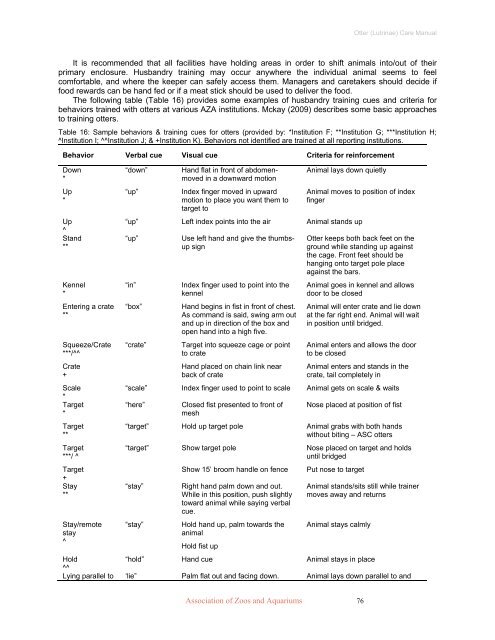Otter (Lutrinae) Care Manual - Association of Zoos and Aquariums
Otter (Lutrinae) Care Manual - Association of Zoos and Aquariums
Otter (Lutrinae) Care Manual - Association of Zoos and Aquariums
You also want an ePaper? Increase the reach of your titles
YUMPU automatically turns print PDFs into web optimized ePapers that Google loves.
<strong>Association</strong> <strong>of</strong> <strong>Zoos</strong> <strong>and</strong> <strong>Aquariums</strong> 76<br />
<strong>Otter</strong> (<strong>Lutrinae</strong>) <strong>Care</strong> <strong>Manual</strong><br />
It is recommended that all facilities have holding areas in order to shift animals into/out <strong>of</strong> their<br />
primary enclosure. Husb<strong>and</strong>ry training may occur anywhere the individual animal seems to feel<br />
comfortable, <strong>and</strong> where the keeper can safely access them. Managers <strong>and</strong> caretakers should decide if<br />
food rewards can be h<strong>and</strong> fed or if a meat stick should be used to deliver the food.<br />
The following table (Table 16) provides some examples <strong>of</strong> husb<strong>and</strong>ry training cues <strong>and</strong> criteria for<br />
behaviors trained with otters at various AZA institutions. Mckay (2009) describes some basic approaches<br />
to training otters.<br />
Table 16: Sample behaviors & training cues for otters (provided by: *Institution F; **Institution G; ***Institution H;<br />
^Institution I; ^^Institution J; & +Institution K). Behaviors not identified are trained at all reporting institutions.<br />
Behavior Verbal cue Visual cue Criteria for reinforcement<br />
Down<br />
*<br />
Up<br />
*<br />
Up<br />
^<br />
St<strong>and</strong><br />
**<br />
Kennel<br />
*<br />
Entering a crate<br />
**<br />
Squeeze/Crate<br />
***/^^<br />
Crate<br />
+<br />
Scale<br />
*<br />
Target<br />
*<br />
Target<br />
**<br />
Target<br />
***/ ^<br />
Target<br />
+<br />
Stay<br />
**<br />
Stay/remote<br />
stay<br />
^<br />
“down” H<strong>and</strong> flat in front <strong>of</strong> abdomen-<br />
moved in a downward motion<br />
“up” Index finger moved in upward<br />
motion to place you want them to<br />
target to<br />
Animal lays down quietly<br />
Animal moves to position <strong>of</strong> index<br />
finger<br />
“up” Left index points into the air Animal st<strong>and</strong>s up<br />
“up” Use left h<strong>and</strong> <strong>and</strong> give the thumbsup<br />
sign<br />
“in” Index finger used to point into the<br />
kennel<br />
“box” H<strong>and</strong> begins in fist in front <strong>of</strong> chest.<br />
As comm<strong>and</strong> is said, swing arm out<br />
<strong>and</strong> up in direction <strong>of</strong> the box <strong>and</strong><br />
open h<strong>and</strong> into a high five.<br />
“crate” Target into squeeze cage or point<br />
to crate<br />
H<strong>and</strong> placed on chain link near<br />
back <strong>of</strong> crate<br />
<strong>Otter</strong> keeps both back feet on the<br />
ground while st<strong>and</strong>ing up against<br />
the cage. Front feet should be<br />
hanging onto target pole place<br />
against the bars.<br />
Animal goes in kennel <strong>and</strong> allows<br />
door to be closed<br />
Animal will enter crate <strong>and</strong> lie down<br />
at the far right end. Animal will wait<br />
in position until bridged.<br />
Animal enters <strong>and</strong> allows the door<br />
to be closed<br />
Animal enters <strong>and</strong> st<strong>and</strong>s in the<br />
crate, tail completely in<br />
“scale” Index finger used to point to scale Animal gets on scale & waits<br />
“here” Closed fist presented to front <strong>of</strong><br />
mesh<br />
Nose placed at position <strong>of</strong> fist<br />
“target” Hold up target pole Animal grabs with both h<strong>and</strong>s<br />
without biting – ASC otters<br />
“target” Show target pole Nose placed on target <strong>and</strong> holds<br />
until bridged<br />
Show 15’ broom h<strong>and</strong>le on fence Put nose to target<br />
“stay” Right h<strong>and</strong> palm down <strong>and</strong> out.<br />
While in this position, push slightly<br />
toward animal while saying verbal<br />
cue.<br />
“stay” Hold h<strong>and</strong> up, palm towards the<br />
animal<br />
Hold fist up<br />
Animal st<strong>and</strong>s/sits still while trainer<br />
moves away <strong>and</strong> returns<br />
Animal stays calmly<br />
Hold<br />
^^<br />
“hold” H<strong>and</strong> cue Animal stays in place<br />
Lying parallel to ‘lie” Palm flat out <strong>and</strong> facing down. Animal lays down parallel to <strong>and</strong>









